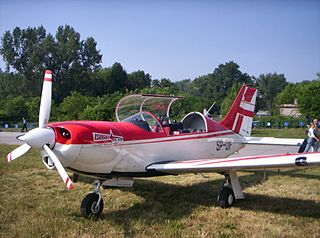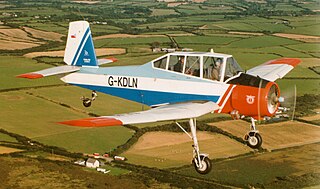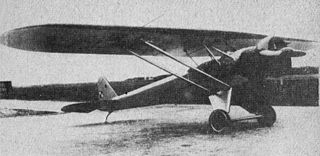
The PZL TS-8 Bies (Devil) is a Polish trainer aircraft, used from 1957 to the 1970s by the Polish Air Force and civilian aviation.

The Ayres Thrush, formerly the Snow S-2, Aero Commander Ag Commander, and Rockwell Thrush Commander, is an American agricultural aircraft produced by Ayres Corporation and more recently by Thrush Aircraft. It is one of the most successful and long-lived agricultural application aircraft types in the world, with almost 2,000 sold since the first example flew 68 years ago. Typical of agricultural aircraft, it is a single-seat monoplane of conventional taildragger configuration. Originally powered by a radial piston engine, most examples produced since the 1980s have been turboprop-powered.

The PA-25 Pawnee is an agricultural aircraft produced by Piper Aircraft between 1959 and 1981. It remains a widely used aircraft in agricultural spraying and is also used as a tow plane, or tug, for launching gliders or for towing banners. In 1988, the design rights and support responsibility were sold to Latino Americana de Aviación of Argentina.

The PZL-Mielec M-20 Mewa is a licence-built version of the Piper PA-34 Seneca II manufactured in Poland by WSK PZL Mielec in a limited series from the 1980s.

The Embraer EMB 202 Ipanema is a Brazilian agricultural aircraft used for aerial application, particularly crop dusting. It is produced by Indústria Aeronáutica Neiva, a subsidiary of Embraer located in Botucatu, Brazil. The latest version of this aircraft is the first ethanol-powered fixed-wing aircraft, which could give it an economical advantage over the gasoline version. The aircraft is widely employed in Brazil, having market share of about 80%, and the 1,000th delivery was completed on 15 March 2005. Besides aircraft, alcohol-conversion kits for gasoline-powered Ipanemas are also sold.

The PZL-101 Gawron (rook) is a Polish agricultural and utility aircraft designed and built by WSK-Okęcie.

PZL M26 Iskierka or M26 Airwolf is a Polish trainer and aerobatic aircraft, designed at WSK PZL-Mielec.

The Air Tractor AT-300 is a family of agricultural aircraft that first flew in the United States in September 1973. Type certification was awarded to Air Tractor in November the same year, and serial production commenced in 1976. Of low-wing monoplane taildragger configuration, they carry a chemical hopper between the engine firewall and the cockpit.

The Zlin Z-37 Čmelák, also known as LET Z-37 Čmelák is an agricultural aircraft which was manufactured in Czechoslovakia. It is powered by a Soviet-built Ivchenko reciprocating engine. The aircraft is used mainly as a cropduster.

The PZL-106 Kruk is a Polish agricultural aircraft designed and built by WSK PZL Warszawa-Okęcie.

The Shvetsov ASh-62 is a nine-cylinder, air-cooled, radial aircraft engine produced in the Soviet Union. A version of this engine is produced in Poland as the ASz-62 and the People's Republic of China as the HS-5.
The PZL M-24 Dromader Super is a single engine agricultural aircraft, developed in the 1980s by the WSK-Mielec from the PZL-Mielec M-18 Dromader. It did not progress beyond the prototyping stage.

The PZL S-4 Kania 2 was a Polish trainer and glider towing aircraft of the 1950s, not built in series. The first prototype was designated S-3 Kania. There is also a helicopter named PZL Kania.

The Commonwealth Aircraft CA-28 Ceres was a crop-duster aircraft manufactured in Australia by the Commonwealth Aircraft Corporation (CAC) between 1959 and 1963. The aircraft was a development of the Wirraway trainer of World War II.

The PZL-102 Kos (blackbird) is a Polish two-seat touring and training monoplane designed and built by PZL.

The PZL S-1 was a Polish trainer and liaison aircraft of 1945, which remained a prototype. It was the second aircraft built in Poland after World War II.

PZL M-2 was a Polish trainer aircraft prototype of 1958, a low-wing monoplane with fixed gear. Designed at WSK-Mielec, it did not enter production.

The PZL M-24 Dromader Mini, originally named the Lama, is a single engine agricultural aircraft, developed in the 1980s by WSK-Mielec from the PZL-Mielec M-18 Dromader. The prototype, registration SP-PDM, first flew on 18 June 1982. It did not progress beyond the prototyping stage.
The PZL M-25 Dromader Mikro is an unbuilt project for a single engine agricultural aircraft, developed in the 1980s by the WSK-Mielec from the PZL-Mielec M-18 Dromader. It did not progress beyond the design stage.
The Hongdu N-5,, originally known as the Nanchang N-5, is a Chinese agricultural aircraft. First flown in 1989, and entering into production in 1992, the N-5 is a single-engined low-wing monoplane, and is available in versions powered by a piston engine or a turboprop.



















